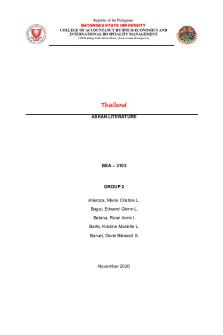Cambodia v. Thailand case analysis PDF

| Title | Cambodia v. Thailand case analysis |
|---|---|
| Author | sagar sifna |
| Course | Corporate Law |
| Institution | Guru Gobind Singh Indraprastha University |
| Pages | 3 |
| File Size | 79.4 KB |
| File Type | |
| Total Downloads | 38 |
| Total Views | 143 |
Summary
this is the case summary of cambodia vs Thailand the famous landmark case...
Description
Author: Sagar Singla, 3rd year student of Gitarattan International Business School, Delhi.
Case: Temple of Preah Vihear (Cambodia v. Thailand) Citation: I.C.J. Reports 1962, p. 6 Date of Decision: 15/06/1962
Issues of the Case: 1. Whether the map was binding or not? 2. Since the Map didn’t follow the true watershed line, so it was void or valid? 3. Thailand accepted the Map or not?
Facts of the Case: 1. The Temple of Preah Vihear is an ancient sanctuary and shrine is situated atop a 1,700-foot cliff in the Dangrek Mountains on the borders of Thailand and Cambodia providing a panoramic view of the plains below. Although now partially in ruins, this Temple has considerable artistic and archaeological interest, and is still used as a place of pilgrimage. 2. The dispute originated from agreements made of 1904–1908. In 1904, Indo China (present-day Cambodia), an Asian country (present-day Thailand) signed an agreement that established that a boundary was to be delimited by a Mixed Commission. The treaty established that the boundary ought to be in accordance with the truth watershed line. 3. Cambodia complained that Thailand had occupied a piece of its territory surrounding the ruins of the Temple of Preah Vihear, a place of pilgrimage and worship for
Cambodians, and asked the Court to declare that territorial sovereignty over the Temple belonged to it and that Thailand was under an obligation to withdraw the armed detachment stationed there since 1954. Thailand filed preliminary objections to the Court’s jurisdiction, which were rejected in a Judgment given on 26 May 1961.
Judgement:
The Map wasn’t binding as it was not created by the Mixed Commission and Thailand claimed that as a result of the Mixed Commission had stopped functioning many months before the Map was created, it was non-binding. Nonetheless, the Map was bestowed to the Siamese government as being the results of the borderline in deep trouble the 1904 pact. The Court found that the Siamese government didn’t complain or raise any objection concerning this at the time of receipt and for several years later. The border from that Map was additionally employed in alternative maps revealed by each party within the years that followed. As such, the Court found that although the Map was at the start non-binding, it gained the character of a binding pact by Thailand and Cambodias’ conduct.
The Map didn’t follow the true watershed line, thus it was void and After the Map had been completed, it was shown to the Siamese members of the Commission, none of the United Nations agencies complained concerning it. An equivalent factor happened with native Siamese authorities: United Nations agencies were acquainted with the world. The Court’s view was that if they didn’t object or complain once the Map was discharged, they cannot complain fifty years later which is very late.
Thailand claimed that, he has never accepted the Map, it was never required to lift the matter throughout the previously mentioned negotiations. It claimed that its body acts established this. The Court checked out the very fact that in 1930 a politician from Thailand was greeted by a Cambodian official once visiting the world. The Court recalled that Thailand had never complained concerning this. Also, the Court discerned that although Thailand had, indeed, shown some administrative body acts, it wasn’t enough to override the consistent administrative position that indicated that they accepted the Map as binding.
Critical Analysis: Through this judgment, the elements of estoppel was seen. The court did not accept Thailand’s idea that it could declare the boundary line as null and void after fifty years. In this case, the International Court of Justice was reluctant to the high degrees to declare the established boundary as void. The court found out that through the conduct made by Thailand, it has accepted that map which ultimately on its own concluded that the Temple was situated on Cambodian territory....
Similar Free PDFs

Lucy v Zehmer case analysis
- 5 Pages

Carlil v carbolic case analysis
- 2 Pages

Haynes v Hardwood(CASE ANALYSIS)
- 5 Pages

Smith V Hughes - Case Analysis
- 6 Pages

6-1 Case Analysis Lucy v Zehmer
- 2 Pages

Doing business in cambodia
- 69 Pages

ASEAN LITERATURE - CAMBODIA
- 15 Pages

Coursework Case - case analysis
- 4 Pages

ASEAN LITERATURE - THAILAND
- 14 Pages

Case Analysis
- 4 Pages
Popular Institutions
- Tinajero National High School - Annex
- Politeknik Caltex Riau
- Yokohama City University
- SGT University
- University of Al-Qadisiyah
- Divine Word College of Vigan
- Techniek College Rotterdam
- Universidade de Santiago
- Universiti Teknologi MARA Cawangan Johor Kampus Pasir Gudang
- Poltekkes Kemenkes Yogyakarta
- Baguio City National High School
- Colegio san marcos
- preparatoria uno
- Centro de Bachillerato Tecnológico Industrial y de Servicios No. 107
- Dalian Maritime University
- Quang Trung Secondary School
- Colegio Tecnológico en Informática
- Corporación Regional de Educación Superior
- Grupo CEDVA
- Dar Al Uloom University
- Centro de Estudios Preuniversitarios de la Universidad Nacional de Ingeniería
- 上智大学
- Aakash International School, Nuna Majara
- San Felipe Neri Catholic School
- Kang Chiao International School - New Taipei City
- Misamis Occidental National High School
- Institución Educativa Escuela Normal Juan Ladrilleros
- Kolehiyo ng Pantukan
- Batanes State College
- Instituto Continental
- Sekolah Menengah Kejuruan Kesehatan Kaltara (Tarakan)
- Colegio de La Inmaculada Concepcion - Cebu





